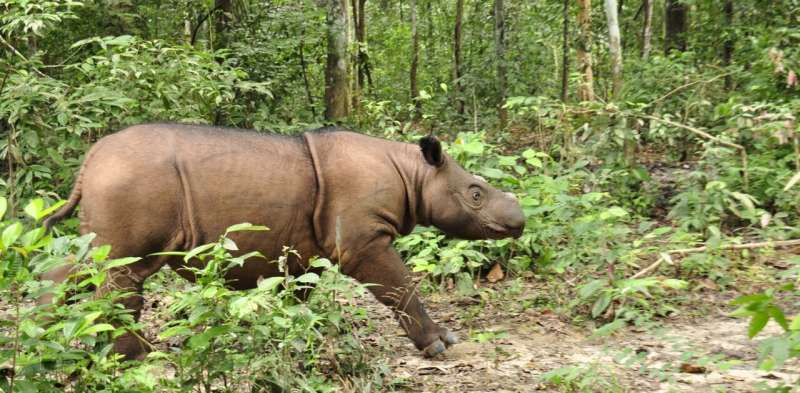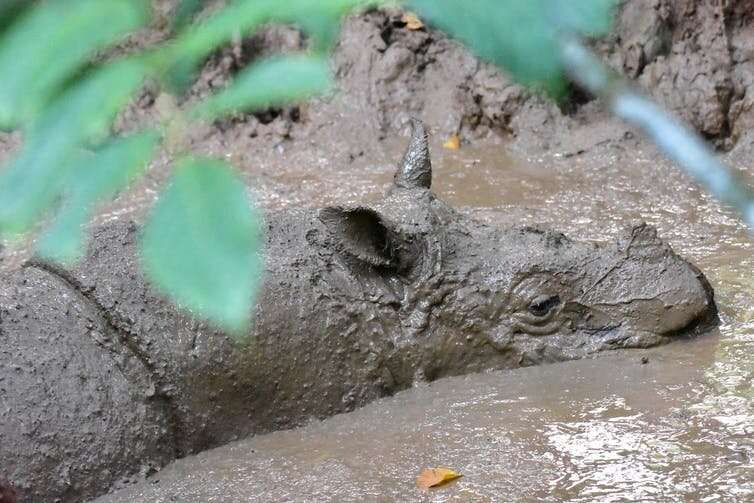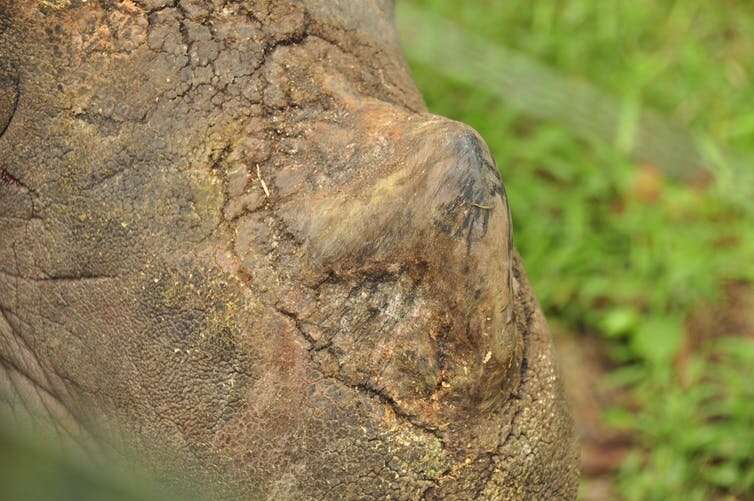Urgent action must be taken to save the critically endangered Sumatran rhino

Indonesia manage to conserve two of the world's five rhinoceros species. Both the Javan rhino (Rhinoceros sondaicus) and the Sumatran rhino (Dicerorhinus sumatrensis) still exist today, uniquely only in the country.
However, there are still challenges to overcome.
The population of the two rhino species are extremely small: each has fewer than 80 individuals. According to the International Union for Conservation of Nature (IUCN) Red List of threatened species, both are now classified as "Critically Endangered"—only one category away from being classed as "Extinct in the Wild."
The conservation efforts of the Javan rhinos have showed positive results in recent years. The population in Ujung Kulon National Park in southwestern Java has grown to 75 individuals.
Conservation efforts of the Sumatran rhino, on the other hand, have faced their own set of challenges.
Based on more than a decade of my experience to support monitoring, protection, and policy-making, as well as extensive communication with activists in the field, here I will explain the Sumatran rhinoceros' unique conditions. I will then highlight urgent actions needed to save them.
An ancient species in the modern era
The Sumatran rhino was once common across Asia, but its population worldwide has decreased by 80% in just three decades.
Recent assessment by the IUCN stated that the overall number of Sumatran rhinos is no more than 80 individuals—only 30 among them are adults. These individuals are dispersed throughout Aceh, Lampung, and Kalimantan.
It is not an easy task to save the Sumatran rhinos, but it is not impossible either. Over time, challenges continued to arise due to their not only shrinking but also scattered population.
Rhinos are herbivores that feed on leaves, buds, and twigs. They consume hundreds of different plants. In the rain forest habitat, rhinos feed on lower stratum plants such as the ginger family (Zingiberaceae), seedlings or young trees from the myrtle family (Myrtaceae), and even Gluta plants (Gluta spp.) that cause rashes when eaten by humans.
Rhinos also often roam in forest gaps, such as those that have been cleared due to fallen trees where regrowth takes place. Rhinos can look for food in the edge of forests, where a lot of seedlings, herbaceous plants, and other food are easily accessible. In order to sustain their lifestyle, rhinos require a diverse range of habitats, including sites for wallowing.
When the world's forests were still intact and human disturbance was still rare, Sumatran rhinos could easily and safely explore, obtain, and enjoy their food and interact with one another.
However, within the last few decades, human activities have increased dramatically.
Extractive industries and large-scale plantations transformed the landscape of Sumatra. As a result, the Sumatran rhino's populations were driven to the corners of their forests—often fragmented and isolated.

As time went by, poaching activities also intensified with various hunting tools. Rhinos became one of the main targets.
Eventually, these rhinos lived an isolated life from one another, while their population continued to decrease.
The rhinos then experienced a phenomenon known as the Allee Effect. This phenomenon begins with the decline in the animal population in a certain area, which then leads to a decrease in their ability to reproduce.
Imagine if this happened to humans, and our species consisted of only 100 surviving individuals, split into five groups on two islands—thousands of kilometers apart. Individual interaction, let alone finding a companion, will be challenging.
This is the Sumatran rhino's main vulnerability today.
Under these circumstances, poaching bans and habitat protection will not be enough to prevent extinction. Critical situations like these can only be alleviated by increasing the birth rate of rhinos.
However, at the same time, the Sumatran rhinos are becoming more fragile due to their peculiar physiology and mating behavior.
Female Sumatran rhinos have only one reproductive cycle every 18–24 days, while the fertility window only lasts 24 to 48 hours. Encounters that occur outside that time window will be futile, and would not produce offspring.
Even if a meeting does take place at the right moment, it may not develop into a meaningful union between the rhinos. This double-horned species has a certain kind of aggressive ritual perhaps to assess the worthiness of a potential mate before reproducing. Partner incompatibility can cause the mating process to fail.
To make matters more complicated, the rhino's shrinking population also increase the risk of inbreeding. This can lead to a variety of undesirable consequences, such as certain illnesses and overall declining fitness.
Unpartnered adult female individuals are at further risk of pathological disorders in their reproductive organs. This can lead to infertility.
Because of these phenomena, slowly but surely the Sumatran rhinos have and likely can continue disappear from their habitats.
The rhino, which had previously endured for possibly millions of years, vanished throughout Peninsular Malaysia, Kerinci Seblat National Park, and Sabah in just 20 years.
Recently, there have been reported signs of rhino extirpation in a number of sites, including Bukit Barisan Selatan and even Way Kambas in Lampung, Sumatra. These reports have not included population conditions in smaller patches in Aceh.

Urgent rescue strategy needed
Three years ago, the government issued an Emergency Action Plan (Rencana Aksi Darurat or RAD) for the Rescue of Sumatran Rhinos.
The plan consists of various strategies for the population recovery, including rescuing rhinos from the wild.
The targeted rhinos are rescued and brought to the Sumatran Rhino Sanctuary—a semi-natural breeding facility. This step was taken to increase the number of rhinos available for semi-natural reproduction, and also assisted breeding through the help of technology.
Before the national rescue plan, there were successful captive breeding efforts, such as those taking place in the Way Kambas facility. With collaboration from the Indonesia government and The Rhino Foundation of Indonesia, two rhino calves named Andatu and Delilah were born in 2012 and 2016. Both have been carefully cared for and are growing healthily to this day.
Besides Way Kambas, there are also another facility built in West Kutai, East Kalimantan. The government plans to develop more of these facilities in Aceh.
These rescue efforts aim to increase the available rhino stock for breeding, as there are now only seven in the Way Kambas facility—with only one pair among them possessing the ability to generate offsprings—and one individual without any mates in West Kutai.
Meanwhile, major initiatives to safeguard rhinos from poaching continue to be part of the national rescue plan as a supporting program.
The implementation of the rescue plan, which has unfortunately been hampered by the pandemic, must be accelerated and regularly evaluated to adapt to new research findings, experiences, and discoveries from the field.
For instance, the conservation strategy in Bukit Barisan National Park or Way Kambas National Park should be updated, because there is new evidence that the rhino population has recently declined and even vanished. When the national rescue plan was put together, the two areas were thought to still have a large number of rhinos.
A recent study also provides valuable insight: most rhinos taken from isolated populations (more than 70%) tend to have pathological disorders in their reproductive organs, such as tumors and cysts that prevent them from conceiving.
Such individuals can actually still contribute to breeding efforts, but require the help of assisted reproductive technology—ART by harvesting gametes or egg cells to produce embryos.
Efforts to search for rhinos eligible for semi-natural breeding should therefore be concentrated on fertile and healthy individuals. These individuals are most probably only available in vast and robust populations—other individuals rescues from isolated areas who are likely to have reproductive problems, need to be supported by ART.
The government need to work in all areas to strengthen conservation strategy: leading the way for rescue efforts, promoting collaboration, and encouraging the involvement of communities and strategic partners.
It is a daunting task, but the recipe, resources and experience for a successful mission are available. It requires the government's adaptive leadership and teamwork with synergy of all parties to accelerate Sumatran rhino recovery.Critically endangered Sumatran rhino pregnant: conservationists
Provided by The Conversation
This article is republished from The Conversation under a Creative Commons license. Read the original article.![]()
No comments:
Post a Comment